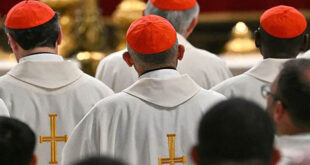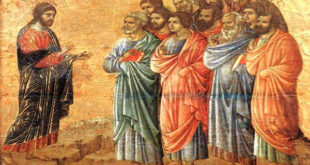The Mass is the heart of Christian life. Since its origins, the Eucharistic celebration has been the supreme act of worship, where Christ’s sacrifice on the Cross is made present in an unbloody manner. However, in the traditional liturgy, there is a particular moment that, for centuries, was carried out in profound silence: the Canon of the Mass.
Why did the priest recite the most sacred words of the Mass in a low voice? What was the meaning of this “silence of the Canon”? In a noisy world, where the sense of the sacred has been fading, rediscovering this silence is an opportunity to deepen our understanding of the beauty of the Eucharistic mystery.
The Origins of the Silence in the Canon
To understand the practice of the silent Canon, we must go back to the early centuries of Christianity. Although the primitive Church did not leave detailed liturgical documents, we know that Eucharistic prayers were considered so sacred that they were recited with utmost reverence and discretion.
In antiquity, the discipline of the “arcane” protected the mysteries of the faith from profane ears. Catechumens (those who were not yet baptized) were dismissed before the Canon, as only the initiated could witness the moment when Christ became present on the altar. This solemnity was maintained and evolved over time.
When the Roman Mass took on its more stable form in the early Middle Ages, the silent Canon became a universal practice. In the Tridentine Mass (established after the Council of Trent in the 16th century), the priest recited the Canon in silence, almost whispering, as an act of reverence before the unfathomable mystery of transubstantiation.
Theological Reasons for the ‘Silence of the Canon’
1. A Mystery That Demands Reverence
The sacrifice of the Mass is not merely a symbolic remembrance of the Last Supper. It is the same sacrifice of Calvary, made present in an unbloody manner. Before such a great reality, silence becomes the most fitting response.
St. John Chrysostom said:
“When you see the priest offering the sacrifice, do not think that he is doing it; it is Christ himself who extends His invisible hands.”
The silence of the Canon emphasized divine action, beyond human words.
2. An Echo of the Old Testament
In the Old Testament, only the High Priest had access to the Holy of Holies in the Temple of Jerusalem, where he entered once a year to offer incense in silence. Similarly, in the traditional Mass, the priest acted in persona Christi, entering into the divine mystery while the congregation worshiped in prayer and recollection.
3. The Humility of the Church Before God
Silence is the attitude of the soul that recognizes its smallness before God. In an era where the liturgy has become more participatory and audible, there is a risk of forgetting that the main protagonist of the Mass is not the assembly, but Christ himself.
Dom Prosper Guéranger, a great restorer of monastic liturgy, stated that the silence of the Canon allowed the faithful to enter into a deeper adoration, engaging in an interior dialogue with God without distractions.
Does This Silence Still Make Sense in Today’s Church?
Since the liturgical reform of the 20th century, the silent Canon has almost completely disappeared. The Missal of Paul VI (Novus Ordo) stipulates that the priest must recite the Eucharistic Prayer aloud. The intention was to make the liturgy more accessible and comprehensible for the faithful.
However, many have expressed that the loss of the silent Canon has reduced the sense of mystery in the Mass. In a culture saturated with noise and distractions, sacred silence is more necessary than ever.
How to Recover the Spirit of the ‘Silence of the Canon’?
Although in most modern parishes the Canon is not recited in a low voice, there are ways to rediscover its meaning:
- Participating in the Traditional Mass: In communities where the Tridentine Mass is celebrated, the faithful can experience the silence of the Canon and understand its spiritual depth.
- Cultivating interior silence: During the Consecration, in any Mass, we can make an effort to recollect ourselves in deep prayer.
- Promoting Eucharistic adoration: Silence before the Blessed Sacrament is a way to better prepare for the mystery that unfolds in the Mass.
- Liturgical formation: Understanding the richness of liturgical tradition helps us to live the Mass with more devotion and meaning.
Conclusion: The Silence That Speaks of God
The ‘silence of the Canon’ was not emptiness, but a language of adoration. In a world where words have been trivialized and noise distracts us from the transcendent, recovering the sense of the sacred is urgent.
St. John of the Cross wrote:
“The Father spoke one word, and that was His Son. And this Word remains in eternal silence, and in silence it must be heard by the soul.”
Christ still speaks to us in silence—the same silence that, in the Mass of all time, enveloped the greatest moment in history: when bread and wine became the Body and Blood of Our Lord.
Today, more than ever, we need to rediscover this silence. Because in it, God still acts.






